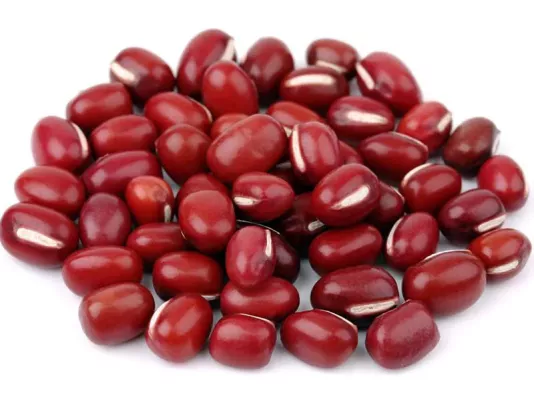Tsubu-An Sweet Bean Paste
Tsubu an sweet bean paste – a Japanese cuisine recipe, this pasta is used to cook the filling for Mochi cakes.

Adzuki Beans are a product I have been working with for a long time, and each time I discover new ways to use them. In my practice, I have noted their easy digestibility and the fact that they do not cause heaviness, unlike some other legumes. Their flavor is delicate, with a nutty note and a subtle sweetness, which makes them perfect for both soups and stews, as well as desserts. I always emphasize: properly cooked adzuki beans should hold their shape but gently open when pressed. If overcooked, the paste becomes sticky and the grains lose their character. The balance of time and temperature is what makes adzuki ideal. In my experience, they pair beautifully with rice, vegetables, and also with fruits and nuts in sweet dishes. For me, adzuki are an example of how a small ingredient can give dishes a special character.
In my practice, choosing adzuki correctly always begins with careful inspection. I always select beans of even color, without spots or cracks, since damaged grains quickly lose flavor. Fresh adzuki have a matte surface and a deep red shade. If the grains are too dull or brittle, it is a sign of long or improper storage. I check the smell: quality beans have a light nutty aroma without mustiness. In my practice, I always store adzuki in glass jars in a dry, dark place. This protects them from moisture and insects, as damp conditions spoil them quickly. When I buy adzuki in large quantities, I always divide them into small batches and freeze part of them: this way they keep their quality for up to a year. I know that freshness directly affects taste: older beans take longer to cook, become tougher, and lose their pleasant tenderness. That is why I always prefer small batches that I use quickly.
When cooking adzuki, I always take their specifics into account. Unlike many other legumes, they do not require long soaking, but I always soak them for at least 2-3 hours. This reduces cooking time and makes the texture more tender. I rinse the beans several times in cold water until the liquid becomes clear: this reduces the risk of an off-flavor. In my practice, it is also important to calculate the amount of water correctly: I use a ratio of 1 part beans to 3 parts water, as they absorb liquid while cooking. I always add a little extra water to avoid drying out. If I plan to make paste for desserts, I cook the beans longer until they become crumbly. For soups and stews, on the contrary, I ensure they stay whole. I always emphasize: it is better to add salt at the end, otherwise the skin hardens and the beans do not cook evenly. In my practice, I have noticed that attention at the preparation stage always guarantees a predictable result.
In my experience, it is temperature control that determines the quality of a dish with adzuki. I always start cooking on high heat, bring it to a boil, then lower it to the minimum and let it simmer slowly. This allows the beans to soften evenly without cracking too quickly. When I make paste for desserts, I cook the beans until they are almost completely soft, as they then easily turn into a tender mass. For soups and stews, I always make sure they stay whole, as that creates an interesting texture. Sometimes I use a slow cooker or steam them if I want to preserve maximum nutrition. I have noticed that too high a temperature makes the skin tough and the center undercooked. That is why slow cooking at low temperature is the key to tenderness for me. I always control the time: usually adzuki are ready in 40-60 minutes, depending on freshness. In my practice, patience at this stage is always rewarded with flavor.
Adzuki beans have a mild sweetness, and I always select ingredients that highlight this quality. In savory dishes, I pair them with rice, carrots, pumpkin, or potatoes: this creates a soft and balanced flavor. In desserts, I often use adzuki with honey, coconut milk, or nuts. They pair well with cinnamon, ginger, and vanilla, which bring warmth and aroma. I have noticed that acidic ingredients such as citrus fruits or berries also balance the natural sweetness well. In my practice, I often make adzuki paste for baking: it has a rich taste and tender texture that makes desserts special. For savory dishes, I use spices like cumin or coriander, which add depth and spiciness. Adzuki are a versatile product that easily adapts to different combinations, and I always see this as their advantage.
Over the years of practice, I have seen many mistakes when working with adzuki. The most common one is underestimating the cooking time: if removed too early, they stay tough, and if overcooked, they turn into mush. I always monitor the texture and taste a few beans before finishing. Another common mistake is adding salt at the beginning, which makes the skin hard. In my practice, I always salt at the end, and this guarantees a tender texture. People often forget about soaking, although even a few hours make a big difference. Another problem is the wrong ratio of water to beans: too little liquid causes burning, and too much dilutes the flavor. I always control this balance. It is also important to store beans correctly: moisture or heat spoils them quickly, and even after cooking the taste becomes dull. For me, quality control lies in attention to detail, and then adzuki beans always turn out tender, aromatic, and healthy.